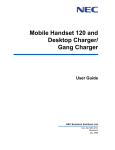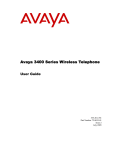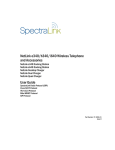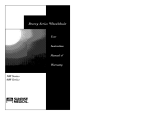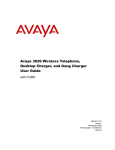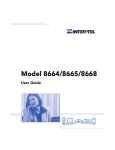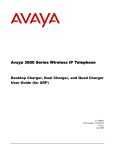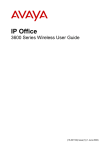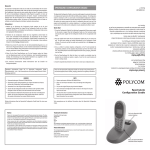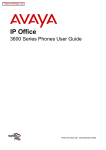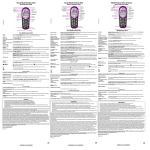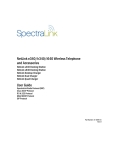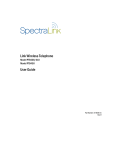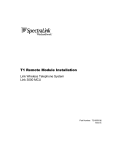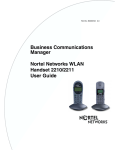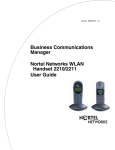Download NEC 110 User's Manual
Transcript
Mobile Handset 110 Wireless Telephone and Desktop Charger User Guide NEC Business Solutions Ltd. Doc. No: NEC-9121 Revision 1 July, 2005 Liability Disclaimer PLEASE NOTE: It is recommended that standard acceptance procedures be followed prior to operating this equipment in proximity of life-support systems. To minimize risk of interference, pacemaker users should not carry the Wireless Telephone next to the pacemaker. Earpiece may retain magnetic objects. Operation of the Wireless Telephone may produce an audible noise noticeable to hearing aid users. It is recommended that a hearing aid compatible headset be used by hearing aid users. WARNING Changes or modifications to this equipment not approved by NEC Business Solutions Ltd. may cause this equipment to not comply with part 15 of the FCC rules and void the user's authority to operate this equipment. NEC Business Solutions Ltd. products contain no user-serviceable parts inside. Refer servicing to qualified service personnel. WARNING NOTE CONCERNING THE WIRELESS TELEPHONES: This device complies with part 15 of the FCC Rules. Operation is subject to the following two conditions: (1) This device may not cause harmful interference, and (2) this device must accept any interference received, including interference that may cause undesired operation. RADIO FREQUENCY (RF) INFORMATION: This equipment has been tested and found to comply with the limits for a Class B digital device, pursuant to Part 15 of the FCC Rules. These limits are designed to provide reasonable protection against harmful interference in a residential installation. This equipment generates, uses and can radiate radio frequency energy and, if not installed and used in accordance with the instructions, may cause harmful interference to radio communications. However, there is no guarantee that interference will not occur in a particular installation. If this equipment does cause harmful interference to radio or television reception, which can be determined by turning the equipment off and on, the user is encouraged to try to correct the interference by one or more of the following measures: • Reorient or relocate the receiving antenna. • Increase the separation between the equipment and receiver. • Connect the equipment into an outlet on a circuit different from that to which the receiver is connected. • Consult the dealer or an experienced radio/TV technician for help. OPERATIONAL WARNINGS: For Vehicles Equipped with an Air Bag: Do not place a portable radio product in the area over the air bag or in the air bag deployment area. An air bag inflates with great force. If a portable radio is placed in the air bag deployment area and the air bag inflates, the radio product may be propelled with great force and cause serious injury to occupants of the vehicle. Potentially Explosive Atmospheres: Turn off your radio product, prior to entering any area with a potentially explosive atmosphere, unless it is a radio product type especially qualified for use in such areas (for example, Factory Mutual Approved). Do not remove, install, or charge batteries in such areas. Sparks in a potentially explosive atmosphere can cause an explosion or fire resulting in bodily injury or even death. CAUTION The areas with potentially explosive atmospheres referred to above include fueling areas such as below decks on boats, fuel or chemical transfer or storage facilities, areas where the air contains chemicals or particles, such as grain, dust or metal powders, and any other area where you would normally be advised to turn off your vehicle engine. Areas with potentially explosive atmospheres are often but not always posted. Batteries: All batteries can cause property damage and/or bodily injury, such as burns if a conductive material such as jewelry, keys, or beaded chains touches exposed terminals. The conductive material may complete an electrical circuit (short circuit) and become quite hot. Exercise care in handling any charged battery, particularly when placing it inside a pocket, purse, or other container with metal objects. Cleaning and Drying Considerations: Using a leather carry case may help protect the surfaces and help prevent liquids (e.g., rain) from entering into the interior of the radio product. This product is not waterproof, and exposing the unit to liquids may result in permanent damage to the unit. If your Wireless Telephone interior gets wet, then do not try to accelerate drying with the use of an oven or a dryer as this will damage the Wireless Telephone and void the warranty. Instead, do the following: 1. Immediately power off the Wireless Telephone. 2. Remove Battery Pack from Wireless Telephone. 3. Shake excess liquid from Wireless Telephone. 4. Place the Wireless Telephone and Battery Pack in an area that is at room temperature and has good airflow. 5. Let the Wireless Telephone and Battery Pack dry for 72 hours before reconnecting the Battery Pack and/or powering on the Wireless Telephone. If the Wireless Telephone does not work after following the steps listed above, contact your dealer for servicing information. Electro Magnetic Interference/Compatibility: Nearly every electronic device is susceptible to electromagnetic interference (EMI) if inadequately shielded, designed or otherwise configured for electromagnetic compatibility. NOTE Facilities To avoid electromagnetic interference and/or compatibility conflicts, turn off your radio product in any facility where posted notices instruct you to do so. Hospitals or health care facilities may be using equipment that is sensitive to external RF energy. Medical Devices Pacemakers: The Health Industry Manufacturers Association recommends that a minimum separation of 6 inches (15 cm) be maintained between a handheld wireless radio product and a pacemaker. These recommendations are consistent with the independent research by, and recommendations of, Wireless Technology Research. Persons with pacemakers should: • ALWAYS keep the radio product more than 6 inches (15 cm) from their pacemaker when the radio product is turned ON. • Not carry the radio product in a breast pocket. • Use the ear opposite the pacemaker to minimize the potential for interference. • Turn the radio product OFF immediately if you have any reason to suspect that interference is taking place. Hearing Aids: Some digital wireless radio products may interfere with some hearing aids. In the event of such interference, you may want to consult your hearing aid manufacturer to discuss alternatives. Other Medical Devices: If you use any other personal medical device, consult the manufacturer of your device to determine if it is adequately shielded from external RF energy. Your physician may be able to assist you in obtaining this information. Use While Driving Check the laws and regulations on the use of radio products in the area where you drive. Always obey them. When using the radio product while driving, please: • Give full attention to driving and to the road. • Use hands-free operation, if available. • Pull off the road and park before making or answering a call if driving conditions so require. INTERNATIONAL CERTIFICATIONS: Australia Brazil NEED NEC BARCODE Canada 2128-K1374 European Union Switzerland Switzerland Japan Mexico New Zealand Singapore Z233 IDA United States United States IEC 60950 Part 15, part 68 MH110 Wireless Telephones SPECIFIC ABSORPTION RATE (SAR) INFORMATION: Your wireless handheld portable telephone is a low power radio transmitter and receiver. When it is ON, it receives and also sends out radio frequency (RF) signals. In August 1996, the Federal Communications Commissions (FCC) adopted RF exposure guidelines with safety levels for hand-held wireless phones. Those guidelines are consistent with the safety standards previously set by both U.S. and international standards bodies: • ANSI C95.1 (1992) American National Standards Institute • NCRP - Report 86 (1986) National Council on Radiation Protection and Measurements • ICNIRP (1996) International Commission on Non-Ionizing Radiation Protection; • DHWC - Safety Code 6 Department of Health and Welfare Canada Those standards were developed by independent scientific organizations through periodic and thorough evaluation of scientific studies. The standards include a substantial safety margin designed to assure the safety of all persons, regardless of age and health. The exposure standard for wireless mobile phones employs a unit of measurement known as the Specific Absorption Rate, or SAR. The SAR limit set by the FCC is 1.6W/kg. NOTE In the United States and Canada, the SAR limit for mobile phones used by the public is 1.6 watts/kg (W/kg) averaged over one gram of tissue. The standard incorporates a substantial margin of safety to give additional protection for the public and to account for any variations in measurements. Tests for SAR are conducted using standard operating positions specified by the FCC with the phone transmitting at its highest certified power level in all tested frequency bands. Although the SAR is determined at the highest certified power level, the actual SAR level of the phone while operating can be well below the maximum value. This is because the phone is designed to operate at multiple power levels so as to use only the power required to reach the network. In general, the closer you are to a wireless base station antenna, the lower the power output. Before a phone model is available for sale to the public, it must be tested and certified to the FCC that it does not exceed the limit established by the government-adopted requirement for safe exposure. The tests are performed in positions and locations (e.g., at the ear and worn on the body) as required by the FCC for each model. While there may be differences between the SAR levels of various phones and at various positions, they all meet the government requirement for safe exposure. The FCC has granted an Equipment Authorization for this model phone with all reported SAR levels evaluated as in compliance with the FCC RF emission guidelines. SAR information on this model phone is on file with the FCC and can be found under the Display Grant section of http://www.fcc.gov/oet/ fccid after searching on FCC ID IYGRNP2400. Additional information on Specific Absorption Rates (SAR) can be found on the Cellular Telecommunications Industry Association (CTIA) web-site at http:// www.wow-com.com. The only authorized headsets that may be utilized with the SNP2400 are those obtainable from SpectraLink or it’s reseller partners. The measured SAR of the SNP2400 Wireless Telephone is 0.61W/kG @ 2462 MHz (head) 0.0379W/kG @ 2412 MHz (body). Phone Operation Normal Position: Hold the phone as you would any other telephone, with the earpiece to your ear and speak into the microphone. The internal antenna is then positioned properly. CAUTION MH120 SPECIFIC ABSORPTION RATE (SAR) INFORMATION: Your wireless handheld portable telephone is a low power radio transmitter and receiver. When it is ON, it receives and also sends out radio frequency (RF) signals. In August 1996, the Federal Communications Commissions (FCC) adopted RF exposure guidelines with safety levels for hand-held wireless phones. Those guidelines are consistent with the safety standards previously set by both U.S. and international standards bodies: • ANSI C95.1 (1992) American National Standards Institute • NCRP - Report 86 (1986) National Council on Radiation Protection and Measurements • ICNIRP (1996) International Commission on Non-Ionizing Radiation Protection; • DHWC - Safety Code 6 Department of Health and Welfare Canada Those standards were developed by independent scientific organizations through periodic and thorough evaluation of scientific studies. The standards include a substantial safety margin designed to assure the safety of all persons, regardless of age and health. The exposure standard for wireless mobile phones employs a unit of measurement known as the Specific Absorption Rate, or SAR. The SAR limit set by the FCC is 1.6W/kg. T NOTE In the United States and Canada, the SAR limit for mobile phones used by the public is 1.6 watts/kg (W/kg) averaged over one gram of tissue. The standard incorporates a substantial margin of safety to give additional protection for the public and to account for any variations in measurements. Tests for SAR are conducted using standard operating positions specified by the FCC with the phone transmitting at its highest certified power level in all tested frequency bands. Although the SAR is determined at the highest certified power level, the actual SAR level of the phone while operating can be well below the maximum value. This is because the phone is designed to operate at multiple power levels so as to use only the power required to reach the network. In general, the closer you are to a wireless base station antenna, the lower the power output. Before a phone model is available for sale to the public, it must be tested and certified to the FCC that it does not exceed the limit established by the government-adopted requirement for safe exposure. The tests are performed in positions and locations (e.g., at the ear and worn on the body) as required by the FCC for each model. While there may be differences between the SAR levels of various phones and at various positions, they all meet the government requirement for safe exposure. The FCC has granted an Equipment Authorization for this model phone with all reported SAR levels evaluated as in compliance with the FCC RF emission guidelines. SAR information on this model phone is on file with the FCC and can be found under the Display Grant section of http://www.fcc.gov/oet/fccid after searching on FCC ID IYGRNP2400. Additional information on Specific Absorption Rates (SAR) can be found on the Cellular Telecommunications Industry Association (CTIA) web-site at http:// www.wow-com.com. The only authorized headsets that may be utilized with the RNP2400 are those obtainable from SpectraLink or it’s reseller partners. The measured SAR of the RNP2400 Wireless Telephone is 0.166W/kG @ 2462 MHz (head) 0.0162W/kG @ 2412 MHz (body). Phone Operation Normal Position: Hold the phone as you would any other telephone, with the earpiece to your ear and speak into the microphone. The internal antenna is then positioned properly. CAUTION i Contents Introduction 1-1 Using this Guide . . . . . . . . . . . . . . . . . . . . . . . . . . . . . . . . . . . . . . . . . . . . . . . . 1-1 How this Guide is Organized . . . . . . . . . . . . . . . . . . . . . . . . . . . . . . . . . . . . . . 1-1 Document Conventions . . . . . . . . . . . . . . . . . . . . . . . . . . . . . . . . . . . . . . . . . . . 1-2 Using the MH 110 Wireless Telephone 2-1 Turning the Wireless Telephone On or Off . . . . . . . . . . . . . . . . . . . . . . . . . . . . 2-2 Making a Call. . . . . . . . . . . . . . . . . . . . . . . . . . . . . . . . . . . . . . . . . . . . . . . . . . . 2-2 Answering A Call . . . . . . . . . . . . . . . . . . . . . . . . . . . . . . . . . . . . . . . . . . . . . . . . 2-3 Activating System Features. . . . . . . . . . . . . . . . . . . . . . . . . . . . . . . . . . . . . . . . 2-3 Using the Softkeys . . . . . . . . . . . . . . . . . . . . . . . . . . . . . . . . . . . . . . . . . . . . . . 2-5 Status Indicators . . . . . . . . . . . . . . . . . . . . . . . . . . . . . . . . . . . . . . . . . . . . . . . . 2-6 The Wireless Telephone Headset . . . . . . . . . . . . . . . . . . . . . . . . . . . . . . . . . . . 2-7 Setting User Preferences . . . . . . . . . . . . . . . . . . . . . . . . . . . . . . . . . . . . . . . . . 2-8 User Option Menu . . . . . . . . . . . . . . . . . . . . . . . . . . . . . . . . . . . . . . . . . . . . . . . 2-8 Battery Packs . . . . . . . . . . . . . . . . . . . . . . . . . . . . . . . . . . . . . . . . . . . . . . . . . . 2-9 Removing and Replacing the Battery Packs . . . . . . . . . . . . . . . . . . . . . . . . . . 2-10 Mobile Handset 110 Wireless Telephone and Desktop Charger User Guide - Revision 1 ii Contents Using the MH110 Desktop Charger 3-1 Using the MH110 Desktop Charger. . . . . . . . . . . . . . . . . . . . . . . . . . . . . . . . . . 3-1 Cleaning the MH110 Desktop Charger . . . . . . . . . . . . . . . . . . . . . . . . . . . . . . . 3-2 Important Notice . . . . . . . . . . . . . . . . . . . . . . . . . . . . . . . . . . . . . . . . . . . . . . . . 3-2 Care of the Wireless Telephone and Chargers 4-1 Precautions . . . . . . . . . . . . . . . . . . . . . . . . . . . . . . . . . . . . . . . . . . . . . . . . . . . . 4-1 Cleaning tips . . . . . . . . . . . . . . . . . . . . . . . . . . . . . . . . . . . . . . . . . . . . . . . . . . . 4-1 Usage Tips . . . . . . . . . . . . . . . . . . . . . . . . . . . . . . . . . . . . . . . . . . . . . . . . . . . . 4-2 Mobile Handset 110 Wireless Telephone and Desktop Charger User Guide - Revision 1 iii Figures Figure 2-1 2-2 2-3 2-4 Title Page Mobile Handset 110 Wireless Telephone . . . . . . . . . . . . . . . . . . . . . . . . 2-1 MH110 Wireless Telephone—display area highlighted . . . . . . . . . . . . . . 2-5 Bottom of the MH110 Wireless Telephone . . . . . . . . . . . . . . . . . . . . . . . 2-7 MH110 Wireless Telephone—back and left side view. . . . . . . . . . . . . . 2-10 Mobile Handset 110 Wireless Telephone and Desktop Charger User Guide - Revision 1 iv Figures Mobile Handset 110 Wireless Telephone and Desktop Charger User Guide - Revision 1 v Tables 1-1 2-1 2-2 2-3 2-4 2-5 Document Conventions . . . . . . . . . . . . . . . . . . . . . . . . . . . . . . . . . . . . . . Call Answering Features . . . . . . . . . . . . . . . . . . . . . . . . . . . . . . . . . . . . . Programmed features . . . . . . . . . . . . . . . . . . . . . . . . . . . . . . . . . . . . . . . MH 110 Status Indicators . . . . . . . . . . . . . . . . . . . . . . . . . . . . . . . . . . . . User Preferences Navigation Tools . . . . . . . . . . . . . . . . . . . . . . . . . . . . User Option Menu Commands . . . . . . . . . . . . . . . . . . . . . . . . . . . . . . . . Mobile Handset 110 Wireless Telephone and Desktop Charger User Guide - Revision 1 1-2 2-3 2-4 2-7 2-8 2-9 vi Contents Mobile Handset 110 Wireless Telephone and Desktop Charger User Guide - Revision 1 1-1 1 Introduction Welcome to the Mobile Handset 110 Wireless Telephone and Desktop Charger User Guide. This guide provides the information you need to use the Mobile Handset 110 (MH110) Wireless Telephone and desktop charger. Chapter Topics • Using this Guide • Document Conventions Using this Guide This guide is designed to make MH110 Wireless Telephones and the MH110 Desktop charger easy to understand and simple to use. There are step-by-step instructions for the procedures you need to perform. How this Guide is Organized Chapter 1 Introduction Chapter 2 Using the MH 110 Wireless Telephone Chapter 3 Using the MH110 Desktop Charger Chapter 4 Care of the Wireless Telephone and Chargers This chapter outlines how to use the manual, including the organization, chapter layout, and conventions used in the Mobile Handset 110 Wireless Telephone and Desktop Charger User Guide. This chapter introduces you to the MH110 Wireless Telephone and describes steps for making, answering, and managing your calls. This chapter describes how to use and clean the MH110 Desktop Charger. This chapter discusses the care of the MH110 Wireless Telephone and the MH110 Desktop Charger. Mobile Handset 110 Wireless Telephone and Desktop Charger User Guide - Revision 1 1-2 Introduction Document Conventions This guide uses the conventions listed in Table 1-1. Table 1-1 Document Conventions When you see: It means: Field names Button names Boldfaced Drop-down list names Example Enter the ID in the Name field. Click Save. Select the names from the Employees drop-down list. Enter login admin at the command Commands, keywords, or other prompt. user input Menu names From the File menu, choose Save. Window names From the Directory window, select Edit > Modify. Dialog box names Click OK to save and close the Account Properties dialog box. Menu paths Select Edit > Modify. CTRL+Shift+S (boldfaced font) Shortcut keys Press CTRL+S to save your changes. F1 Function keys Press F1 to access the online help. Capitalized Menu > Submenu (boldfaced font) CTRL+S Click Right-click Click the left mouse button Click OK to save your changes. Click the right mouse button Right-click and select Delete from the shortcut menu. Warning Used to warn against possible human injury or risk of death from an action or event. Caution Used when equipment or data could be damaged by an action or event. Important Emphasizes a MUST read statement. Mobile Handset 110 Wireless Telephone and Desktop Charger User Guide - Revision 1 Introduction When you see: It means: 1-3 Example Note Used to point out special details that you must know or actions that you must take relevant to your current actions. Tip Describes time-saving ideas and other useful information for completing procedures. Reference Indicates a reference to another related document. Step-by-step instructions are numbered. If more than one option is available to complete a task in a procedure, the options may appear as follows: Step 1 Do one of the following to add a field to the Employee directory. —Select the desired field from the Employee field and click Add. —Double-click the desired field from the Employee field. Step 2 To select all of the available fields, click Add all. Mobile Handset 110 Wireless Telephone and Desktop Charger User Guide - Revision 1 1-4 Introduction Mobile Handset 110 Wireless Telephone and Desktop Charger User Guide - Revision 1 Using the MH 110 Wireless Telephone 2-1 Using the MH 110 Wireless Telephone This chapter introduces you to the MH110 Wireless Telephone and describes steps for making, answering, and managing your Wireless Telephone. Figure 2-1 shows the main elements of the MH110. Figure 2-1 Mobile Handset 110 Wireless Telephone Line Indicators Left arrow Low battery icon Earpiece Right arrow Voicemail icon Up Select Down Start Menu & Main display area Softkey Function display area Softkey A Softkey B Softkey D Softkey C Power Off/End Call Menu Power On/Start Call Function Line Microphone Charging contacts Headset jack (not to scale) Chapter Topics • • • • • • • • • • • Turning the Wireless Telephone On or Off Making a Call Answering A Call Activating System Features Using the Softkeys Status Indicators The Wireless Telephone Headset Setting User Preferences User Option Menu Battery Packs Removing and Replacing the Battery Packs Mobile Handset 110 Wireless Telephone and Desktop Charger User Guide - Revision 1 2-2 Using the MH 110 Wireless Telephone Turning the Wireless Telephone On or Off Use the following steps to turn on your MH 110 Wireless Telephone. Step 1 Press and hold the Power On/Start Call key for about one second. Two chirps will sound. Step 2 Release the Power On/Start Call key and the in-service tone sounds as the extension number displays. The Wireless Telephone is now in standby mode and ready to make and receive calls. Use the following step to turn off your MH 110 Wireless Telephone. Step While in standby mode, press and hold the Power Off/End Call key. One chirp sounds and the Wireless Telephone turns off. The Wireless Telephone cannot be turned off during a call. End the call first and then turn the Wireless Telephone off. NOTE Making a Call Use the following steps to make calls. Step 1 Go Off Hook by pressing the Power On/Start Call key. Step 2 Press the LINE key to select a line and the number key of the line you wish to use. You may hear a dial tone. Your telephone system may require you to select a line before dialing a number. NOTE Step 3 NOTE Dial the number. Dial calls with the Wireless Telephone exactly as with your desk phone. You may dial extension numbers, internal numbers, or make external calls, depending on the setup of your PBX. If you hear a dial tone, just press the number keys to dial the number. Mobile Handset 110 Wireless Telephone and Desktop Charger User Guide - Revision 1 Using the MH 110 Wireless Telephone 2-3 Answering A Call When an incoming call is received the Wireless Telephone rings or vibrates to alert you of an incoming call. Additionally, a line number on the display may flash, and the display may show information about the call, such as caller's name and extension. To answer a call, press the Power On/Start Call key, hold the earpiece to your ear, and speak with a normal tone of voice. Using Call Waiting If you are on a call and hear subdued ringing, a call is coming in on a second line. The line number on the display may be flashing. Use the following steps to answer this call. Step 1 Press the Hold key to put your first call on hold. Step 2 Press the LINE key and the line number of the second call at the same time. Pressing the LINE key and then pressing the line number of an incoming call disconnects the call in progress unless HOLD is activated. IMPORTANT Table 2-1 describes available features for answering calls. Table 2-1 Call Answering Features Features Actions Headset Answer When a headset is plugged into the Wireless Telephone, any key other than the Power On/Start Call, Power Off/End Call, softkeys or side buttons may be pressed to answer a call. Hanging Up At the end of each call, press the Power Off/End Call key. Be sure to do this at the end of each call. Changing Volume You may increase or decrease the volume of the speaker by pressing the corresponding Up and Down buttons located on the left side of the Wireless Telephone. Silencing while Ringing If the ringing of the Wireless Telephone is not desired, you may silence the ring by pressing the Power Off/End Call button. This action does not interrupt the call and the caller may leave a voicemail message. Backlight The backlight comes on when any key is pressed or when there is an incoming call and stays on for 10 seconds. It turns off after 10 seconds if another key is not pressed within that period. Activating System Features The features that have been programmed in your system may be viewed and activated through the Shortcut Menu and Softkey Functions. Mobile Handset 110 Wireless Telephone and Desktop Charger User Guide - Revision 1 2-4 Using the MH 110 Wireless Telephone Table 2-2 describes the features that have already been programmed in your system. Table 2-2 Programmed features Features Descriptions The Shortcut Menu System features that are accessible by the MH110 Wireless Telephone may be viewed by going off hook (pressing the Power On/Start Call key) and then pressing the MENU key. A feature menu displays in the main display area. This is the shortcut menu. The shortcut menu lists the feature shortcut, if any, and the feature description. As you scroll through the features by pressing the Up and Down buttons, the feature abbreviation is highlighted in the softkey function display area. To activate a feature, you may press its softkey, its shortcut key, or the Select button while the option is highlighted. Using the Select button To use the Select key, press Up or Down to highlight an option, then press Select to activate the feature. Using the shortcut keys Programmed features may have the number 1-9, *, 0, or # in the left column of the shortcut menu. This is the shortcut key that activates that feature. To activate the feature using its shortcut key, press the shortcut key while in the shortcut menu. The feature activates whether or not that feature is currently displayed or highlighted. Note: No shortcut indicates that the feature does not have a shortcut and this is generally the case with primary level softkey functions. An example of using the shortcut keys follows. Example: If the Transfer feature is programmed to shortcut key 2, the Shortcut Menu displays: 2 Transfer Use one of the following steps to activate the Transfer feature when the Transfer option is highlighted in the menu. Xfr will be highlighted in the softkey function display area. NOTE Step Press 2. Step Press the corresponding softkey. Mobile Handset 110 Wireless Telephone and Desktop Charger User Guide - Revision 1 Using the MH 110 Wireless Telephone 2-5 Step Scroll to the option and press Select. Step Press MENU + 2 to activate the Transfer feature if you are not already scrolling through the shortcut menu. In certain system environments, the softkeys and the MENU key are unavailable. In such environments, press the FCN key while off hook to scroll through system features. Press the shortcut key to activate the feature. NOTE Using the Softkeys The softkeys on your MH110 Wireless Telephone enable you to quickly activate system features. There are four softkeys and up to 16 features programmed for softkey access. The display area directly above each softkey is programmed with a feature abbreviation to guide your access to the feature. The softkeys are referred to from left to right as A,B,C,D. In Figure 2-2 the corresponding display area is labeled Aaaa, Bbbb, Cccc, Dddd. Figure 2-2 MH110 Wireless Telephone—display area highlighted Line indicators Left arrow Low battery icon Up Select Down Softkey A Softkey B Power On Start Call Function Earpiece Right arrow Voicemail icon Shortcut Menu & Main display area Softkey Function display area Softkey D Softkey C Power Off End Call Menu Display area Line Microphone Charging contacts Headset jack The softkeys operate with a toggle function. Press the left or right side of the key to activate the corresponding softkey feature. The first four primary softkey features are displayed in the softkey function display area by default. Use the following steps to view all of the features that can be activated through the softkeys. Step 1 Briefly press the Power On/Start Call key to go off hook. Mobile Handset 110 Wireless Telephone and Desktop Charger User Guide - Revision 1 2-6 Using the MH 110 Wireless Telephone Step 2 Press the FCN key. The second set of feature abbreviations displays in the softkey display area (Figure 2-2). —Each time the FCN key is pressed, a different set of features displays until all 16 possible features have been displayed. —The softkey features display in the same sequence as they appear on the shortcut menu. Step 3 Press the corresponding softkey to activate any feature while its abbreviation is displayed. Activating Features With The Shortcut keys While scrolling through the softkey functions, a shortcut key may be pressed to activate its corresponding feature, whether or not that feature is currently displayed in the softkey function display area. Because system features vary, your system administrator will explain them in reference to your telephone system. Example: Using the previous example for the Transfer function described on page 2-4: If the Transfer function is assigned to softkey A in the second level row, then Xfr displays in the Aaaa softkey display area when the FCN key is pressed. If a call is in progress, do one of the following to activate the Transfer feature: • Press FCN + (softkey A) to transfer the call. • Press FCN + 2 to use the shortcut key. • Press MENU + 2. Refer to the example of using the shortcut keys on page 2-4 for more information about using MENU + 2. REFERENCE Status Indicators Table 2-3 describes the status indicators in the MH 110 Wireless Telephone. Mobile Handset 110 Wireless Telephone and Desktop Charger User Guide - Revision 1 Using the MH 110 Wireless Telephone 2-7 Table 2-3 MH 110 Status Indicators Status Indicators Descriptions No Service Message An alarm sounds and a descriptive message displays when the Wireless Telephone cannot receive or place calls. You may be outside of the covered area. Walk back into the coverage area. The in-service tone indicates service is re-established. If functionality does not return, note the error message and contact your system administrator. The battery icon displays and a soft beep will be heard while the Wireless Telephone is in use whenever the Battery Pack charge is low. User has 15-30 minutes of Battery Pack life left. Battery low This message will display and an alarm will sound while the Wireless Telephone is idle whenever the Battery Pack is critically low. The Wireless Telephone cannot be used until the Battery Pack is charged. The voicemail icon indicates that you have a new voicemail message. Melody A melody is played after the Wireless Telephone is powered on for the first time following a completed charge (Charge Complete). The Wireless Telephone Headset NEC Business Solutions Ltd. offers optional headsets for use in noisy environments or if you need to have your hands free while talking on the Wireless Telephone. To use the headset, simply plug it into the jack on the bottom of the Wireless Telephone. The headset is specially designed to work properly with the MH110 Wireless Telephone. We do not recommend using other headsets. Figure 2-3 Bottom of the MH110 Wireless Telephone Headset jack Charging contacts Mobile Handset 110 Wireless Telephone and Desktop Charger User Guide - Revision 1 2-8 Using the MH 110 Wireless Telephone Setting User Preferences User preferences can be set through the vertical menus when the Wireless Telephone is in standby mode (on, but not in use). Use the following steps to set user preferences. Step 1 Place the Wireless Telephone in standby mode. Refer to “Turning the Wireless Telephone On or Off” on page 2-2 for more information regarding turning on the telephone. REFERENCE Step 2 Press and briefly hold FCN to display user options. Check with your system administrator for specific features supported by your Wireless Telephone. NOTE Table 2-4 describes navigation tools that can be used when configuring user preferences. Table 2-4 User Preferences Navigation Tools Features Up/Down buttons Select button OK softkey Descriptions Displays previous/next menu item. Selects the menu item or option. Completes selection of the menu item or option. Save softkey Saves the entry. Bksp softkey Backspaces to allow editing of entry. Cncl softkey Cancels edit and returns to previous menu level. Up softkey Returns to previous menu level. Exit softkey Exits the menu (at the top level). END CALL key Exits to standby state (from any level). User Option Menu Table 2-5 describes commands located on the User Option Menu. Table 2-4 on page 2-8 describes available navigation tools. REFERENCE Mobile Handset 110 Wireless Telephone and Desktop Charger User Guide - Revision 1 Using the MH 110 Wireless Telephone 2-9 Table 2-5 User Option Menu Commands Commands Descriptions Actions Ring Type Select Telephone Ring to set the standard ring on the Wireless Telephone. Press 0 to select desired ring type. The ring type currently set displays with an asterisk. • Normal: is the factory default ring. • Vib/Norm ring: vibrates for five seconds and then rings. • Vibrate ring: vibrates for a non-audible call alert. Noise Mode Adjusts the Wireless Telephone to account for background noise. Select an option that describes the noise in your environment. • Normal: for most office environments • High: for moderate background noise • Severe: for extremely noisy conditions. Current IP address In IP systems, the IP address of the Wireless Telephone is displayed. This number may not be edited. None. Extension Sets the extension number associated with your Wireless Telephone. This number is used to identify the Wireless Telephone and is for display purposes only. Use keypad to enter extension number. Additional options may be present. Contact your system administrator for information. NOTE Battery Packs The Wireless Telephone’s Battery Pack must be recharged periodically. The Nickel Metal Hydride (NiMH) rechargeable Wireless Telephone Battery Pack gives you four hours of talk time or 80 hours of stand-by time. Stand-by time is when the phone is turned on, but not in an active call. NOTE Mobile Handset 110 Wireless Telephone and Desktop Charger User Guide - Revision 1 2-10 Using the MH 110 Wireless Telephone Low Battery Indicator The low battery icon displays when the Wireless Telephone battery is running out of power. If the Wireless Telephone is in use, a soft beep also sounds through the earpiece every six seconds indicating that the user has 15-30 minutes of battery life remaining. If the Wireless Telephone is not in a call when the battery begins to run out of power, only the low battery icon displays. If the battery is not recharged and becomes critically low, a Low Battery message displays and a loud beep sounds. The Wireless Telephone will not work until the Battery Pack is recharged. CAUTION Be careful not to short-circuit the battery contacts on the Battery Pack. Batteries can be short-circuited if metal objects such as coins, keys or paper clips cause a direct connection of the battery terminals. Shorting the contacts can cause permanent damage. Removing and Replacing the Battery Packs Use the following steps to remove and replace battery packs. Step 1 Press down on the latch on the Battery Pack on the back of the Wireless Telephone. The Battery Pack releases outward as shown in Figure 2-4. Figure 2-4 MH110 Wireless Telephone—back and left side view UNIVERGE WL System Wireless Telephone (back and left side) with Battery Pack ajar Up Select Down Latch Battery pack Lip Mobile Handset 110 Wireless Telephone and Desktop Charger User Guide - Revision 1 Using the MH 110 Wireless Telephone Step 2 Slide the lip of the Battery Pack into the bottom of the cavity. Step 3 Push the top of the Battery Pack until it snaps into place. 2-11 You should not have to force the Battery Pack into the Wireless Telephone. NOTE Changing the Battery Pack During a Call The Battery Pack may be changed while a call is still in progress. Use the following steps to remove and replace the battery pack while in a call. NOTE If you are using the Telephony Gateway in your telephone system, do not press Power Off/End Call on the Wireless Telephone before beginning the following steps. Step 1 Quickly remove the discharged Battery Pack and replace with a charged Battery Pack. Refer to “Removing and Replacing the Battery Packs” on page 2-10 for detailed instructions. REFERENCE Step 2 Press Power On/Start Call to turn the Wireless Telephone back on. Step 3 Press Power On/Start Call again to resume the call in progress. Users of IP telephony interfaces not requiring the UNIVERGE WL System Telephony Gateway should Park a call prior to changing the Battery Pack during an active call. The call should then be retrieved after the Battery Pack is replaced to rejoin the conversation. Check with the switch administrator for instruction on how to perform this or a similar process on your particular telephone system. REFERENCE Mobile Handset 110 Wireless Telephone and Desktop Charger User Guide - Revision 1 2-12 Using the MH 110 Wireless Telephone Mobile Handset 110 Wireless Telephone and Desktop Charger User Guide - Revision 1 3-1 3 Using the MH110 Desktop Charger The MH110 Desktop Charger is designed to charge the Nickel Metal Hydride (NiMH) Battery Packs. Full charging is accomplished in approximately one and a half hours. Chargers operate in a 50° to 85° F (10° to 30° C) environment. Do not expose them to freezing temperatures or direct sunlight. The MH110 Desktop Charger is shipped with the appropriate power supply for the site's location. Place the MH110 Desktop Charger on a flat, horizontal surface. Plug the power supply into the MH110 Desktop Charger and into an appropriate wall outlet. CAUTION Chapter Topics Do not place anything in the MH110 Desktop Charger other than the Wireless Telephone. You might damage the contacts. Bent contacts can keep the Wireless Telephone from charging. • Using the MH110 Desktop Charger • Cleaning the MH110 Desktop Charger • Important Notice Using the MH110 Desktop Charger The user must end any call in progress by pressing the Power Off/End Call button on the Wireless Telephone before placing the handset into the MH110 Desktop Charger. The Wireless Telephone may be off or in standby mode during charging. Indicator Light Place the MH110 Wireless Telephone into the MH110 Desktop Charger slot facing forward. If the Wireless Telephone is placed correctly, the red indicator light will come on. The indicator light will not come on when the slot is empty, when the MH110 Wireless Telephone is improperly seated, or when the MH110 Desktop Charger has no power applied. Charging Indicator If the Wireless Telephone is in standby mode, it displays its extension number and Charging. . . . If the Wireless Telephone is turned off, only Charging. . . displays. The dots will be racing during the charging cycle. It is normal for the Battery Pack to become warm when charging. Charge Complete Charge Complete displays when the Wireless Telephone is fully charged. The indicator light remains on until the Wireless Telephone is removed. Mobile Handset 110 Wireless Telephone and Desktop Charger User Guide - Revision 1 3-2 Using the MH110 Desktop Charger Cleaning the MH110 Desktop Charger Clean the MH110 Desktop Charger by wiping the surface with a clean, water-dampened cloth or paper towel. A mild detergent solution may be used. Be sure to wipe away any detergent residue with a plain water dampened cloth. DO NOT IMMERSE THE MH110 Desktop Charger IN WATER OR OTHER LIQUID. DO NOT POUR LIQUIDS INTO THE SLOT. IMPORTANT The Battery Pack contacts on the Wireless Telephone may be cleaned with isopropyl (rubbing) alcohol applied with a Q-tip, cloth, or paper towel. Do not push or pull the exposed Battery Pack contacts. Important Notice • Never use non-NEC Business Solutions Ltd. charging units as they could damage the Battery Pack. • Only use the original plug-in power adapter for the MH110 Desktop Charger. • Do not dip the Battery Pack in water or throw into the fire. • Do not throw away the Battery Pack with your domestic waste. Take used Battery Packs to an appropriate collection point for recycling or send them back to your supplier or servicing agent. Replacement Battery Packs are available from your supplier or servicing agent. Mobile Handset 110 Wireless Telephone and Desktop Charger User Guide - Revision 1 4-1 4 Care of the Wireless Telephone and Chargers Precautions and tips contained in this chapter apply equally to the MH110 Wireless Telephone and the MH110 Desktop Charger. Chapter Topics • Precautions • Cleaning tips • Usage Tips Precautions Do not drop Avoid dropping the Wireless Telephone or knocking it against hard surfaces. Carrying the Wireless Telephone in a holster or carrying case will help to protect it. Do not disassemble There are no serviceable parts in the Wireless Telephone or MH110 Desktop Charger. You should not open the Wireless Telephone case nor disassemble the MH110 Desktop Charger. Doing so will void your warranty. Cleaning tips Use the following cleaning tips to maintain your Wireless Telephone and Desktop Charger. • Turn off the Wireless Telephone and unplug the MH110 Desktop Charger before you clean them. Please observe the following guidelines: • Never immerse either in water. • Clean the exterior surfaces, including the charging contacts, with a cloth that has been slightly moistened with water. • Do not exert undue pressure on the MH110 Desktop Charger electrical contacts while wiping. Mobile Handset 110 Wireless Telephone and Desktop Charger User Guide - Revision 1 4-2 Care of the Wireless Telephone and Chargers • Wiping the handset surface with a water-dampened cloth or paper towel will remove most films or residues. • If the soiling is too stubborn for plain water, a mild detergent solution may be used. • Wipe away any detergent residue with a clean water-dampened cloth. • The Wireless Telephone may be cleaned with any general-purpose household glass and surface-type cleaner. • Isopropyl alcohol may be used occasionally, applied by a cloth or paper towel. • When using alcohol, do not rub the keypad characters vigorously. Doing so will significantly degrade legibility. DO NOT SPRAY THE HANDSET DIRECTLY! CAUTION • Pre-treated cloths such as used for eyeglasses or cameras may be used to clean the phone. Pre-moistened towelettes may also be used to clean the phone, however, avoid those containing lanolin or aloe as it will leave a slippery residue. • The surface of the handset may be cleaned occasionally with disinfectants used for general cleaning in a medical environment. • Isopropyl alcohol may be used occasionally applied by a damp cloth or paper towel. When using alcohol, do not rub the keypad characters vigorously. Doing so will significantly degrade legibility. • Do not use furniture polishes, waxes or plasticizer-based cleaners. • Do not use lanolin, aloe, glycerin or other skin care type products. • Do not apply any solvent such as acetone, mineral spirits etc. • Do not directly spray or immerse the handset. • If the headset connector becomes dirty, a scratchy or intermittent signal may be experienced. To clean the connector, dip the nonpadded end of either a wooden or paper handled cotton swab in isopropyl alcohol. Gently insert in the connector and twist, repeating several times. If available, blow compressed air into the connector to clear debris. Usage Tips Please observe the following usage guidelines: • Before you use the Wireless Telephone, the Battery Pack must be charged. • You can only use the Wireless Telephone with your facility's telephone system. It is not a public cellular phone. • Keep the Wireless Telephone away from your ear when it is ringing. Mobile Handset 110 Wireless Telephone and Desktop Charger User Guide - Revision 1 Care of the Wireless Telephone and Chargers 4-3 • The microphone is between the FCN and LINE keys. This is a sensitive microphone that works well when the Wireless Telephone is correctly positioned on your ear. There is no need to speak directly into the microphone, but do not cover it with your hand or cheek when talking. • The LCD panel displays information about the status of your Wireless Telephone and prompts you about features. • If the Battery Pack is low, you will hear a soft beep and see the battery icon in the display. • Improper disposal of Battery Packs can damage the environment. Dispose of batteries properly. • You can control the Wireless Telephone volume level and the type of ring. • To protect the Wireless Telephone, use a carrying case. Mobile Handset 110 Wireless Telephone and Desktop Charger User Guide - Revision 1 4-4 Care of the Wireless Telephone and Chargers Mobile Handset 110 Wireless Telephone and Desktop Charger User Guide - Revision 1 For additional information or support on this NEC Business Solutions product, contact your NEC Business Solutions representative. NEC Business Solutions Ltd. Mobile Handset 110 Wireless Telephone and Desktop Charger User Guide NEC-9121, Revision 1












































